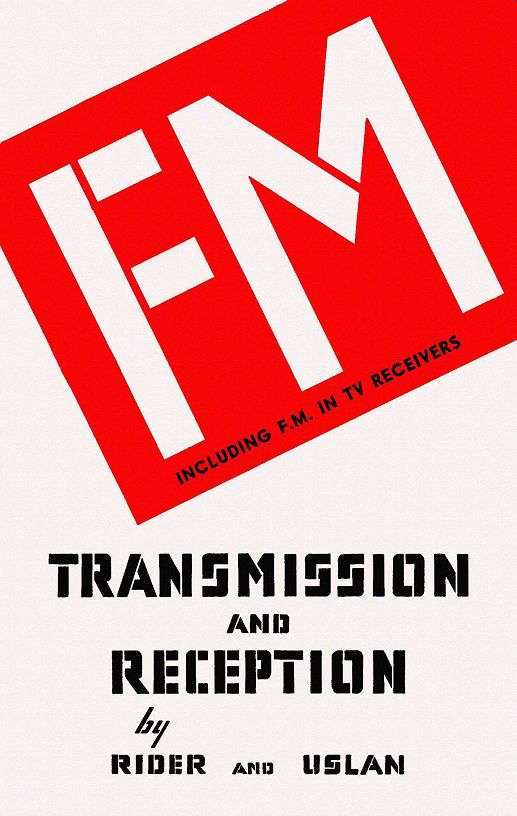Contents:
PART I -- TRANSMISSION
3. ESSENTIALS OF FM TRANSMITTERS
5. THE TRANSMISSION OF FM SIGNALS
PART II -- RECEPTION
10. FM IN TELEVISION RECEIVERS

PREFACE
FREQUENCY MODULATION in general needs no introduction to the man who is interested in radio communication, no matter how remotely -- he hears about it and sees references to it daily -- it is literally thrust upon him from every side. Because of its comparatively recent entrance into the communication picture, only a relatively few books about FM have appeared, and these have been introductory in nature for the most part.
Naturally when something new is brought out, numerous questions arise in the mind of every technically inclined man as to how and why it functions and how it can be employed. This guide is intended to answer as completely as possible those questions about FM, and material has been included which hitherto has not been published.
Due to the importance that FM has assumed within the last decade, we have incorporated in this guide those basic principles underlying the operation of the complete FM transmitter as well as the receiver, the discussion of transmitters embracing both the narrow-band and wide-band types that are being manufactured today for service in many different fields. Here both direct FM and indirect FM (p-m) transmitters are considered with all the essential theory necessary for a complete understanding of FM and p-m transmission. In order that the FM picture may be complete, the subject of both transmitting and receiving antennas is covered and then the various types of receivers, their functioning and servicing. In short, FM is considered from the point in the transmitter where it first becomes a modulated signal until it is translated into sound energy by the loudspeaker in the receiver.
The guide is divided into two parts: the transmission of the FM signal in the first and its reception in the second. In the first part, the underlying theory of FM and p.m. is included as well as the propagation of FM signals, the basic characteristics of FM transmitters and an analysis of transmitters that are in use today. In no other guide of its kind, will there be found as complete a coverage of FM transmitters as in this one. The first part closes with a discussion of the latest in transmitting antennas.
The second part of the guide deals with FM receiving antennas and the FM receiver. The discussion of the latter takes into account every individual stage relative to FM and compares them to a-m sets. At the time of writing, four different types of FM detectors are in use: the limiter-discriminator type, the ratio detector, the oscillator detector (locked-in oscillator) and the FreModyne detector, and these are discussed in detail. The last two Sections are devoted to the alignment and the servicing of receivers and in the appendix will be found some data on the use of vectors and other pertinent information of value.
It is believed that this guide will afford the reader an opportunity to gather and understand all the features of FM starting from the transmitter and working straight through the receiver. In order to achieve fully the desired simplicity, mathematics have been kept to the necessary minimum and illustrations have been employed liberally so that a clearer picture of the whole topic would be given the reader.
The authors wish to extend their gratitude to Major Edwin H. Armstrong, the Federal Telephone and Radio Corp., General Electric Co., Western Electric Co., Raytheon Mfg. Co., Westinghouse Electric Corp., and others for supplying them with technical data which are included in this guide and for their cooperation. Appreciation is also extended to Richard F. Koch, of the John F. Rider Laboratories, for his help in reading the manuscript of this guide and for his suggestions.
December 18, 1947; JOHN F. RIDER; SEYMOUR D. USLAN
PREFACE TO THE NINTH PRINTING
The principal change in this new printing of "FM" Transmission And Reception" is the inclusion of a set of questions at the end of each Section. These questions were inserted in order to make this text more useful to technical schools, as well as to the reader that uses the text for self-study.
It was felt that the student, or reader using the guide for self-study, should understand the principles brought out in each Section and the questions have been prepared with this thought in mind.
Besides the insertion of the questions there have also been a number of revisions in the text material itself. The majority of these changes are due to revisions in certain governmental regulations.
May 1, 1949; JOHN F. RIDER; SEYMOUR D. USLAN
PREFACE TO THE SECOND EDITION
Because of the current rapid growth of television it was felt necessary to devote a new Section to FM in television receivers. This appears as Section 10 in the second edition of this guide.
November 30, 1950; JOHN F. RIDER; SEYMOUR D. USLAN
+++++++++++
Also see:
++++++++++++